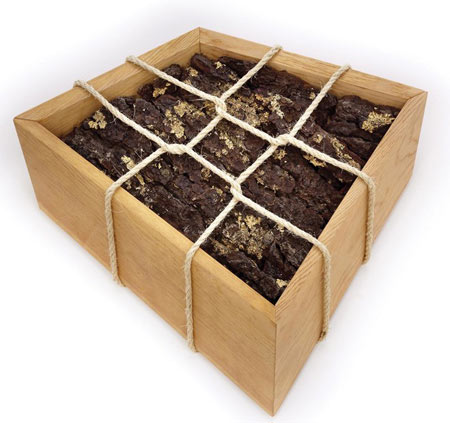
An aptly titled and tasteful exhibit of the works of three contemporary artists, “Perception” plays very nicely on the ambiguous trope of perspective and trompe l’oeil trickery. It all hinges on the artificial construct of single point perspective, a device that originated in the 15th century and was first expounded by Leon Battista Alberti in his Treatise on Painting. “Alberti’s most obvious contribution to the art of painting,” writes John R. Spencer, “is his exposition of the one-point perspective system which makes its first appearance in theory in this work.” And it is the construction of this one-point perspective system, which “provides the artist with a means of creating apparent space in his painting.”
With deft artistry and near flawless workmanship, the creation of illusionistic space is exactly what the three artists in this exhibit achieve. And the wonder is that these deceptions of the real hang flat against the wall with an understated insistence on the flat and inherently artificial nature of the work of art.
Veteran California minimalist sculptor Tony Delap has mounted works of utter simplicity, fastidiously fashioned, that tease and refute the impulse to see the real from the slightest visual cues. A work like “Certain,” made from cantilevered aluminum painted green, convinces us as we approach it in the gallery space of its volumetric nature. But pacing around it we see that the barest additions have created an illusion. Similarly, Delap’s “Red Crimp” uses a keystone viewing effect and drop shadow to convince us of solidity when, in fact, none exists. This is illusion as a tease. “The Courtly Card” is a reference to his well-documented love of magic and his long history with sleight of hand card tricks for which Delap has designed his own playing cards.
John Okulick’s wood constructions are the most illusory of the works in this exhibit. When viewed in a flat photograph the works appear as if they are sitting on a gallery floor. But they are, in fact, hung on a wall and provide an astonishing depth of perspective. And there is great wit in the fact that the imagery refers to volume, appearing to be wooden boxes containing various objects from chopped tree limbs to sections of golf balls. These works are visual puns of the highest order. “Outside-In” depicts a wooden box that appears to contain tree bark roped within the four walls of the box. Okulick “ropes us in” to believing in his visual trickery. “Slice,” a reference to a golf shot careening wildly off course, depicts severed golf balls apparently resting in yet another cantilevered wood box. “Reins of Darkness” includes fire-blackened kindling enclosed by reins of rope, as if to signal the persistence of the real after lambent representation has dimmed.
Single point perspective informs the work of Jeremy Kidd. His large chromogenic print collages mounted on aluminum panel are built up as panoramas of a single location. A multitude of single points of view, often made with long exposures of a high-resolution digital camera, are arrayed to form a cyclorama in space and time that is at once recognizable but strangely altered. Because the individual exposures last as long as two minutes, the separate sections depict a different time of day or night. And they are all stitched artfully together to form a monumental hybrid that is both familiar and alien. The piece titled ”LACMA” will be recognizable to denizens of Los Angeles, but, in a marvelous stroke of visual compression, it conjoins a long swath of Wilshire Boulevard that is taken in with a single gaze. Similarly, the piece titled “Thames” provides a privileged view of time elapsing as the eye saccades, in a way that is only possible through art. “Ruby City” depicts yet another familiar corner of Wilshire Boulevard, transforming it into a kind of nocturnal OZ of urban imagination.
When Alberti wrote his treatise, he was attempting to devise perspective as a means for the artist to create a temporal, spatial and visual unity. It was necessary for Modernism, repeatedly, to subvert Alberti’s invention. Now, surprisingly, it has become a highly expressive device in the hands of these three artists.
Published courtesy of ArtSceneCal ©2011
